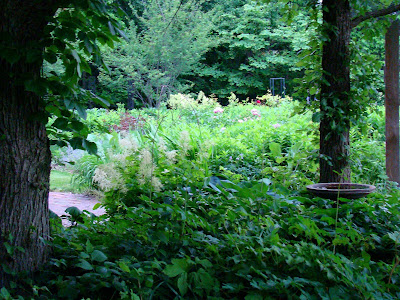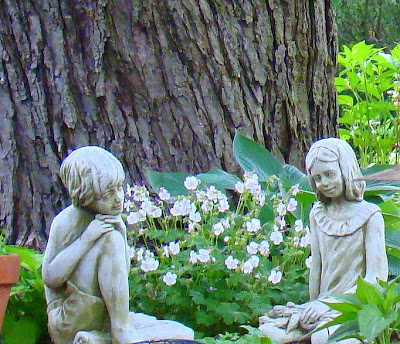Last Saturday I joined local Master Gardeners for a tour of
Possibility Place, a native plants nursery in Chicago's south suburbs. We met at the Extension office. Our morning began with a bit of excitement, when Sue, (our Master Gardener Coordinator) spotted a large turtle preparing to lay her eggs right at the curb in a front garden near the office's parking lot.

Not the safest place for mother or babies, one of the braver among us scooped her up as she hissed and complained, and moved her across the street, back to where she probably came from. Then we were off for our short ride to the nursery.

As we pulled into the driveway, the first thing we saw was this wonderful old barn. Possibility Place is so much more than a nursery.

Wisteria was blooming on the lovely arbor entrance.

I had to get a closer look at the weather vane on top of the arbor.

We did some preliminary exploring as we waited for our tour. We had to laugh when we came across this garden ornament.

Peeking through the woods, this friendly scene caught my eye.

Just as the clouds opened, we were greeted by Connor Shaw, the nursery's owner and our tour guide. Due to the rain, Connor decided to start our tour in one of the greenhouses.

We learned a lot about the rewards, methods, and challenges of growing and selling native trees, shrubs, and perennials.
 Connor Shaw (with raindrop on the camera lens)
Connor Shaw (with raindrop on the camera lens)

Here, he's showing us one of his very special plug trays. Possibility Place uses a very different, (and expensive) container system for growing these plants. The holes in the sides and bottoms of the containers encourage roots to branch, instead of growing around the sides and bottoms.
Once a root tip hits the air, it stops growing. Using this method, known as air-root-pruning, stimulates root branching and produces a substantial, non-circling fibrous root system. This results in greater root tip surface area, allowing better absorption of water and nutrients, better growth, establishment, and vigor, and ultimately better plant health at the nursery, and later, in our gardens.

Earlier this spring I was impressed with how well the plants I purchased from a couple of native plant sales had already established and grown in my garden. The organizations hosting the sales had gotten their plants from Possibility Place. Learning about Connor's superior growing methods, I understood why the native plants I purchased were doing so well.
 one lovely view after another.
one lovely view after another.Just about the time Connor was wrapping up his presentation inside the greenhouse, the rain stopped. We were able to go back outside to check out more of the beautiful grounds, with Connor as our expert guide.
 one of several beautiful gardens on the nursery's grounds.
one of several beautiful gardens on the nursery's grounds.Our discussion continued, with Connor talking about the native trees, shrubs, grasses, sedges, rushes, and forbs he grows on the grounds, his philosophies, and his extensive knowledge and experience.
 white baptisia - isn't it gorgeous?
white baptisia - isn't it gorgeous?
He discussed his design philosophy, identified many plants and discussed their cultural requirements, and talked about how he grows his gardens, 'stacking and packing' the plants. Stacking is planting by height, with trees, shrubs, and larger plants in the backs of the borders, shorter plants towards the front.
Packing is planting more closely than conventional wisdom might dictate, shading the soil better and leaving little light or space for weed growth. I was very happy to hear someone with his experience talking about this kind of spacing. (I tend to plant more closely than plant labels suggest.)

swamp rose - wonderfully fragrant.
Not only was I happy to hear that he plants this way, I felt the results spoke for themselves. The gardens are naturalistic and beautiful. Nothing looked overcrowded, and everything looked healthy and happy.

native honeysuckle - much more interesting and beautiful than the imported, invasive honeysuckle.

yet another lovely view. A few annuals add color.
I jumped at the opportunity to attend this field trip. It was only last year that I first heard of Possibility Place, as I was looking for a local supplier of native plants. I did already have some natives in the garden, and wanted to add more. Last year I became aware of a couple of local, annual native plant sales. I wasn't able to check them out due to conflicts in my work schedule, but learned that the plants were locally-grown at Possibility Place, this hidden south-suburban gem.
Primarily a wholesale grower, Possibility Place also sells to the general public. Choose plants through the catalog, call to place your order, and make an appointment to pick up your plants - it's that easy! Your plants will be set aside and ready for payment and pickup. They don't ship, but for us locals that's ok, because you'll really want to get a peak at this gorgeous, inspiring place.

Thank you so much Connor, for sharing your passion for native plants, for being so generous with your time and knowledge, and for letting us pick your brain! It was a pleasure and privilege meeting you, and a great learning experience. I think it's safe to say we all left with lots of information, ideas and inspiration, and an increased appreciation for native plants and the challenges and rewards you experience growing them for us.
 Catalpa tree in bloom
Catalpa tree in bloom
 Cukes are happy.
Cukes are happy. Tomatoes are blossoming (sorry about the blurry photo.)
Tomatoes are blossoming (sorry about the blurry photo.) But I have no complaints.
But I have no complaints. . . . No baby squash yet, but the vines are growing and blooming beautifully.
. . . No baby squash yet, but the vines are growing and blooming beautifully. The peas are still growing, blooming, and producing in spite of the heat. With the arrival of 90-degree temps, some vines are beginning to dry out. I remove them, leaving those that are still producing. Peas are interplanted with squash, pole beans, and cucumbers on the trellis in my small garden.
The peas are still growing, blooming, and producing in spite of the heat. With the arrival of 90-degree temps, some vines are beginning to dry out. I remove them, leaving those that are still producing. Peas are interplanted with squash, pole beans, and cucumbers on the trellis in my small garden. Garlic scapes have been removed. (Aren't they cute?) I've never grown garlic before, and learned about removing the scapes from Gina. They are delicious! Last week I sauteed some with fresh asparagus. Yum!
Garlic scapes have been removed. (Aren't they cute?) I've never grown garlic before, and learned about removing the scapes from Gina. They are delicious! Last week I sauteed some with fresh asparagus. Yum!






























 The Palm House, restored in 2003, is home to 84+ varieties of palms. This huge Scheelea palm was sprouted from a seed in 1926 during an expedition to Brazil, led by Chicago's Field Museum of Natural History. The poem below was included on the plaque describing this specimen:
The Palm House, restored in 2003, is home to 84+ varieties of palms. This huge Scheelea palm was sprouted from a seed in 1926 during an expedition to Brazil, led by Chicago's Field Museum of Natural History. The poem below was included on the plaque describing this specimen:











